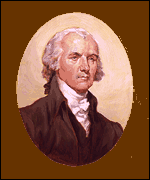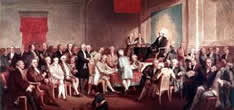
The War of Independence ended in October 1781 with the surrender of Cornwallis's troops at Yorktown. Even though British forces remained in America, the British government decided that the cost of continuing the war was prohibitive. The formal treaty granting American independence was signed in Paris in 1783. In addition to acknowledging American independence, the Treaty awarded very generous boundaries to the United States, granted fishing rights to Americans off the coast of Newfoundland, recognized the validity of debts that remained unpaid, and urged the restoration of any confiscated property to the original owners, mostly Loyalists. Separate treaties resolved issues involving the other nations connected with the conflict, including the return of the Florida territory to Spain. Although the major cause of the war had been met, much work remained to be done. The Continental Congress that had existed before the war had become the Confederation Congress, whose structure was contained in the Articles of Confederation. That structure, however, would not prove sufficient to govern what would eventually become a vast nation spreading across the continent of North America. Rather than a consolidated nation, the Articles created what might reasonably be called the United Nations of North America. If the former colonies had continued under the Articles, the future history of the United States would certainly have been very different.
It is worth noting that Article XIII of the Confederation document would become significant later. It states in part that “the union shall be perpetual.” Since the Constitution was designed to create “a more perfect union,” the fact that the Articles were perpetual meant that secession was unconstitutional, as the Supreme Court ruled in 1869.
Under the Articles, the individual states saw themselves as sovereign entities, and the Confederation Congress had virtually no power whatsoever over the combined affairs of the states. The Articles provided for no executive authority, merely a Congress. In addition, there was no court system, nor, in fact, any real central authority. Problems had existed during the war, though General Washington had persevered despite haphazard support from what was supposed to be a national government. Although in some ways less critical, the problems that existed following the war continued to point out the weaknesses of the existing arrangement. More needed to be done. Some sort of stable government structure had to be created, and the result was the Constitution. Even that monumental step, however, could not guarantee the long-term success of the enterprise. It had to be tested, and many differences existed about how the Constitution should be interpreted. The period between 1783 and 1800 was critical. By the time Thomas Jefferson and the Republicans were elected in 1800, the future course of American history was suggested. We examine the Federal Period, 1783-1789, in this section.
Readings
- America under the Articles
- Constitutional Convention
- Keys to the Constitution
- America in the 1790s, Part 1
- America in the 1790s, Part 2
- Recommended Reading: Constitution
- Impeachment
 James Madison
James Madison
docs
- Virginia Statute on Religious Freedom
- Virginia Bill of Rights
- Blacks Petition
- Articles of Confederation
- The Northwest Ordinance
- The United States Constitution
- Constitutional Convention Debate
- Henry on the Constitution
- Franklin on the Constitution
- Washington's Farewell
- Jefferson Letter on Rebellion
- Kentucky and Virginia Resolutions

External Links
- Library of Congress Guide
- American Revolution Home
- George Washington Papers
- National Constitution Center
- Yorktown
- Saratoga
- National Park Service
- Valley Forge
- Constitution Society
- Cowpens Battlefield
- Learn more about Historical Autographs

| Sage American Home | American Revolution Home | Constitution | Federal Period | Updated February 7, 2023 |